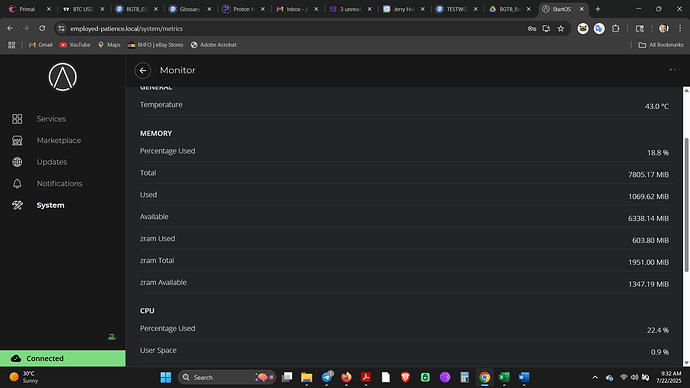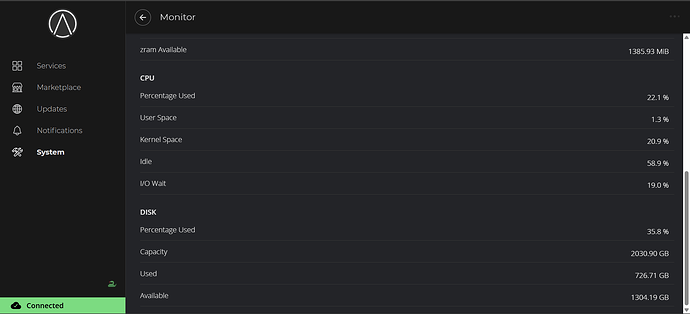Been going like this for 5 days. It moved fine at first now it increments only about .01% during every two errors. Its constantly cycling between error and syncing. Is this normal. No power outages, and I am on a fast network. I have a 2 TB SSD on a Dell Latitude 7050.
With the lack of available info, my guess is you don’t have enough RAM. Keep in mind that you’re not simply downloading the blockchain. You’re cryptographically verifying every single transaction. It’s getting into the hard part now. The more recent blocks are mostly full. The UTXO set is huge, and the average transaction is way more complex. This last 25 percent will take longer than the entire first 75%, to verify. Sometimes by a lot. What you are experiencing is typical of under powered hardware. The 7050 is almost 10 years old. Your processor could be lacking, and you really need at least 16GB or RAM, to not have a bad time. If you have enough RAM, you can help speed up the IBD by increasing the Database cache. I’d set it to 6,144. Just remember to put it back 450 after it’s done. It would also be a good idea to stop all other services from running while the IBD is in progress.
I appreciate the detailed reply. Its at 78.71% now. So it is making very slow progress. I will find all of the hardware specs. Maybe there are adjustments we can make. Or decide if this hardware is too slow.
Here is a screenshot of the last part of Start OS System/monitor.
I made the changes to the Disk Cache as you suggested. And it restarted automatically. It appears to be running ok. And even a little bit faster. The processor is an Intel I5-7500T with 4 cores and 4 threads at 2.7GHz. It has an SSD with 2 TB.
If there are other services running. I didn’t start them. How would I stop them? When I click on services it only show Bitcoin core.
I appreciate all of your help. I understand this is a volunteer project and you have other work to do.
With only 8GB or RAM, It’s going to struggle a little bit. I’d try setting the database cache to 2048. You need RAM for the UTXO set. But I would avoid going higher than half the installed RAM. None of this is gospel, and you can find lots of opinions out there about this. The IBD might take a week or two to complete. But I think your performance will be okay after that. At least for the time being. If you haven’t installed any other services, then no other services are running. Hold off on doing so until the Initial Block Download is complete. The IBD is probably the singularly most resource intensive thing you will have your server do.
Thanks Rexter. I understand. Hopefully I have the resources. I travel a lot so I am away from home for extended periods of time. But it does appear to be going a bit faster than the last few days. I have it set at 2048 for the database cache. I did some rough calculations. And it appears it will take approximate four more days to complete the IBD.
It will be longer ![]()
Maybe so. I guess it slows down as it progresses.
I was just joking, but it might. I built a lot of low-end servers when I was experimenting with building the cheapest possible system, and that last stretch of the IBD was always brutal.
I get it. And I am feeling that now. I didn’t think this was such a low end server. But I guess it is. First I heard about folks using a Rasbery PI is all you need. Then I heard that was not enough. Then I heard all you need is an old laptop or an old PC. Spent money on the SSD. So I built a Bitcoin Core node on windows (by the way the IBD on this laptop was only three days). But it was unreachable by my Sparrow wallet unless it was on the same local LAN. And I travel a lot. Then I tried the old laptop with Start OS. But that didn’t turn out to be right either. It was in good working order and performed well. But the BIOS is impossible to change the boot order to have it boot off the SSD. So now it sits in the closet. Then I moved to this Dell Optiplex 7050. With a good Intel processor, and a usable BIOS. And I have my doubts about it. If I would have bought a Start 9 server at the beginning I would have probably been OK, and spent about the same amount of money. Now I am trapped in the sunk cost fallacy of make this work or lose my investment. They are sold out of servers anyway. I am stuck trying to make this one work. In a short while I will be traveling again and not be here to work on it. I really wanted to build a node for me and my family and friends. But I am having doubts now.
Just my opinion, but I think you’ll be fine with the 7050 for a couple of years at least. Once you get past the IBD it’ll be fine. I have a node that took over a month for the IBD, but it’s fine for running a node with lnd, and Alby Hub. I think it has a Core 2 Quad processor. It completely chokes on electrs, and mempool though.
3 years ago, you could run a full Bitcoin stack on a Raspberry Pi, but things are changing fast, and the the interwebs are really bad a purging outdated info.
Thanks man. Good information. And lessons learned in real time. I will keep going as long as my schedule permits. I believe I will need Electrum Server to run also. Since I will need remote access to my Node. And as I understand it ES is required for this. This is what ended my first adventure, months ago. I couldn’t access my node remotely. And I couldn’t install ES since I was running Bitcoin core on a Windows machine. And you are right about current information. Onward, I am at 82.30%.
Personally, I only meant “low end” relative to modern computers, not relative to what can run a Bitcoin full node. For the latter, it really is all about the RAM, thanks to the spammers. The other requirements are quite low. Probably coming in second place after RAM size is file IO speed (but that’s mainly because it makes up for low RAM, though, so it really is all about the RAM). From my own tests, an old, refurbished computer with max 16GB DDR3 is probably the best low-budget system, and it’ll run a node quite well and complete the IBD in a little over a day.
You can technically still run a full node on a low-memory Raspberry Pi with enough swap space reserved (as long as it is one of the models with USB 3.0). The IBD takes months though, and I expect it will stop working at some point when the amount of swap needed exceeds the USB 3.0 bandwidth.
Interesting to know. I am doing pretty well on Internet Bandwidth. Fast.com is showing around 400 Mbps. Thanks for the information.
Yep, and unfortunately, despite the word “Download” being in the name, the internet bandwidth isn’t the primary factor in the IBD as you are discovering. Maybe the name should be changed to IBV to highlight the “Verifiy” process. ![]()
Good point. I am learning a lot.
I’m having a similar experience with StartOS on older hardware… I wish I understood the issue with RPC timeouts on Bitcoin (Core or Knots) with StartOS vs other iterations of Linux as its not just the hardware. I’m learning StartOS and have a been testing on an old Raspberry PI 4 64bit with 8GB of RAM and was told on the forum the CPU was not enough for Bitcoin, so I wiped StartOS from the Raspberry PI 4 and put Raspberry PI OS 64bit back on it, then used my old Mac Mini a1283 with 8GB of RAM and a 2 TB drive to load StartOS on it and let them both load the entire blockchain. That was over a month ago.
Raspberry PI 4 with Knots took just over 1 week, with the obvious slow down during the last few days.
Mac Mini a1283 with StartOS and Knots slowed down at 65% (about 2 weeks in) and since then it has RPC errors almost everytime I check it. For the last 2 weeks I’m lucky to get 1% verified / day.
I have another local node and would like to try to point a StartOS node at a local node and see how this goes… does anyone have instructions on how to do that with StartOS?
For the Mac Mini a1283, were you using an SSD or HDD?
Wow. That was a long time. I am now at 91.39%. I am getting soooo close. If I had to do this again. I would have definitely had a stronger machine.
If you ever need to in the future (for example, if the power cuts and the blockchain data gets corrupted), just add 8GB more RAM and the same machine will likely go from a couple weeks to a couple days.

